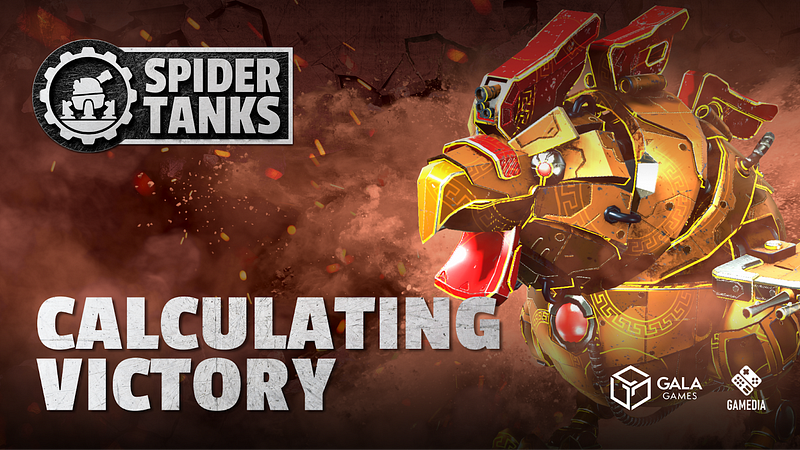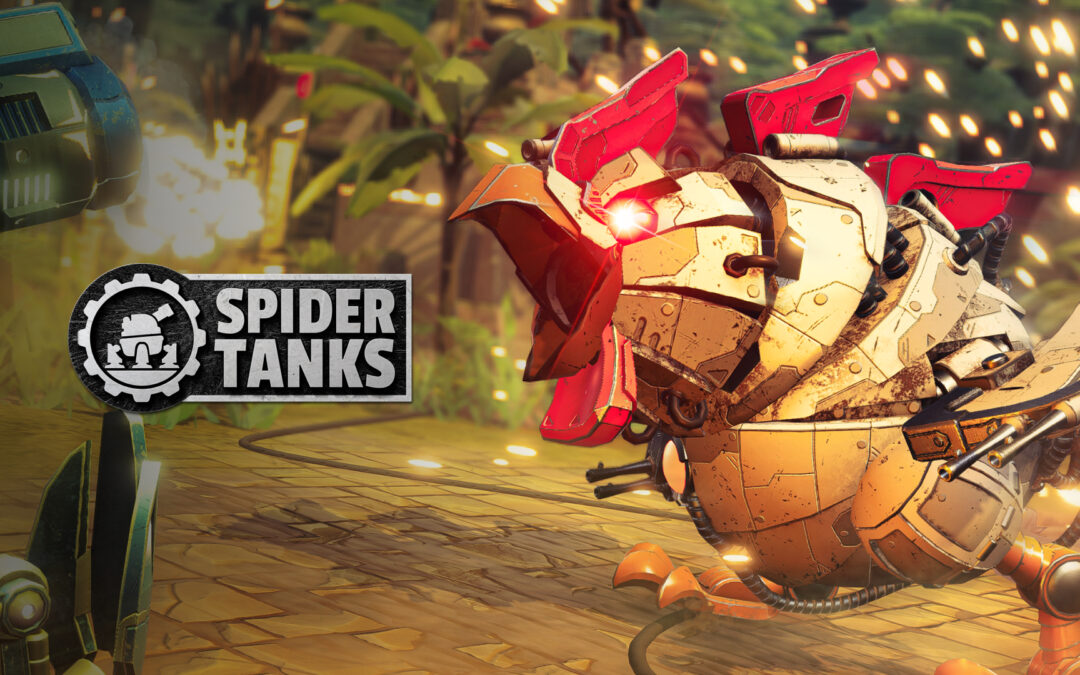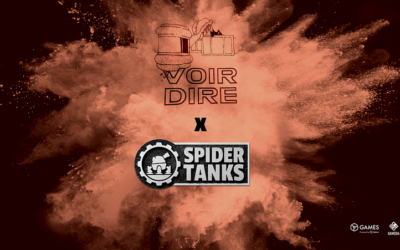Alright Pilots, get yourself some scratch paper and let’s dive into the numbers behind battle rewards!
Battles in the arena are– in a way– their own reward. The thrill of victory, the smell of burning fuel… this is what true arena champions are all about, but Spider Tanks brings you rewards that go a little beyond the pure satisfaction of destroying your opponents.
Today, we’re going to dive into the Victory Point formula for battles and hopefully shed some light on the finer functions of the great machine that is the arena. This will let all Pilots plan out their entire rise to glory from their humble beginnings to their highest hopes of Tank Pilot glory.
The Victory Points (VPs) you could potentially win each match are influenced by a number of factors. Your Rank, the rarity and level of your Tank Parts, and how many battles you’ve already won using those specific Parts that day are the major variables in how many VPs you’ll rack up from each victory. Other factors– such as Honor– may also eventually affect your potential VPs.
Note: This is a snapshot of how the VP battle reward system currently works at the time of this article. Fun gameplay, balance and sustainability will always be priorities of Spider Tanks. If necessary, this formula may be altered in the future to better support those core goals.
Base VP Potential
Determining the amount of VP you could earn from each win starts with your base potential. This is a set number for each rarity and level to which multipliers are applied to reward you VP. Each Tank Part has an independent value for its potential VP… even if it’s a Hero Tank that was purchased as a package, all Weapons and Bodies are accounted for separately in VP calculations.
Weapons tend to have roughly 30% more VP potential from each win than Bodies of equal rarity and level. This is due to the original pricing disparity between Weapons and Bodies. As Weapons often define a playstyle more than Bodies, this also helps discourage players from swapping out Bodies only to augment VP without the work of mastering another Weapon in the arena.
The following charts represent the base theoretical maximum VP potential of each rarity/level Tank Part for a particular day. This is before any modifiers are applied for Rank or upgrade quality.
You’re welcome to pick through these numbers and check out what the potential for your specific build is, but even at a glance it should be obvious how important the level of any specific Part is in relation to VP potential. Once other factors are introduced, this base number will massively affect your overall VP gain from wins, as multipliers can make minor changes in your level more pronounced.
Starting Strong
Now that we’ve discussed the intrinsic VP potential of each rarity and level of Tank Part, let’s get into what factors influence that to arrive at the amount of VP you receive from each win.
First off, each win in a given day with a specific Tank Part will reward diminishing VPs. As we said earlier, the charts above are to indicate what the theoretical maximum is for a particular Part, but in reality you’ll continue to win diminishing amounts of VP indefinitely. The first few wins each day will give you a much larger share of VPs than your 19th and 20th.
By 5 wins in a day, you should be just shy of 50% of your Tank Part’s total theoretical potential. At 10 wins, you’ll have received around 75% of that total potential. By 20 wins, you’ve received right about 95% of all total VP you could possibly get from that Tank Part that day. You’ll never totally stop winning VP with any Part, but the amount you receive will continue to diminish exponentially as you win more and more.
Swapping out Tank Parts doesn’t have to be done at the same time to get your full VP. Each is factored separately then added together to give you your total VP from winning a match. If you’ve already won 10 matches on a Titan/Crossbow and you swap out the Crossbow for a Cannon you haven’t used that day but keep the Titan, you’ll be getting a fresh flow of potential VP from the Weapon, but your Body will still have the diminishing returns of 10 matches won.
Upgrade Quality
Every upgrade on a Tank Part randomizes several stats independently of each other within a range. The overall quality grade (Decent, Good, Great, Excellent, Perfect) is a generalized measurement of how high these rolls are rather than the factor that determines them. The best upgrades are called “Perfect”, but one Perfect may be slightly numerically better than another.

For VP calculations, the quality of all your upgrades up to level 30 is taken as a percentage measurement of how close to numerically perfect they cumulatively all are together. This is used to determine a multiplier between 1 and 2 applied to your base VP potential.
A level 0 Tank Part (or a Tank Part with the worst possible upgrades each level!) is 0% quality, so its multiplier would be 1. A level 30 Part with only absolutely mathematically perfect upgrades would be 100% quality, thus a multiplier of 2. It’s important to note that it’s incredibly unlikely any Tank Part will ever have a full multiplier of 2 in this calculation.
This crucially assumes 100% quality is 30 levels of totally mathematically perfect rolls. A level 15 Weapon with absolutely perfect rolls to that point would be 50% quality (15/30) and have a multiplier of 1.5.
Upgrade costs increase as you get higher, spread across all Components required by the specific Part. Weapons cost more to upgrade than equivalent Bodies, in line with their increased potential VP. At a different level for each Part and rarity, upgrades will begin to require Arachnium and will require increasing amounts until level 30. Epic rarity and higher Tank Parts will require Arachnium starting at the first upgrade, though they do start at a higher level.
Battle Ranking
Your overall Elo rating is the number behind that bar that fills up or drops down when each match ends. This number is used for matchmaking and Rank calculations and increases or decreases based on your wins and losses, but also on your performance in each match, how successful your opponents were in other matches, etc. Though at this scale and speed the system can seem complex, it’s something most people are very familiar with. It is the same basic ranking system used by most major sports leagues.

This Elo rating is also (at the time of writing this article) the only factor in VP calculation that does not rely on your specific Tank Parts. This one is all about you as a Pilot!
The multiplier from your Elo can be anywhere from .5 to 2 depending on your overall position among active players. The lowest Elo score in the game has a multiplier of .5– halving VP received from any win. The highest Elo score will have a multiplier of 2 — doubling VP received from any win. The vast majority of players will fall somewhere in the center of this spectrum, but increasing your rating relative to other players will always increase the multiplier applied to your VPs.
Adding It All Up
So now that we know what factors go into VP calculation, we can simplify it down to a pretty basic equation for how many VPs you’ll receive from your first win each day.
VP=(VPbase) x (Quality Multiplier) x (Elo Multiplier)
After the first win you’ll receive gradually less from each until a new day starts, but you can use the charts above to estimate what that base should be after you reach your win goal for the day.
The SILK distribution based on daily VP you win varies depending on a number of factors. More SILK spent within the Spider Tanks Ecosystem results in more SILK being distributed, whereas more SILK in circulation but not being spent results in less SILK being distributed daily.
This distribution is designed to gravitate around 1000 VP resulting in one SILK during that day’s distribution, but it could be higher or lower any given day depending on the factors mentioned above. This figure also depends on consistent spend in-game, and if users stop burning SILK, there will obviously be no SILK to be added to the remint quantity, reducing this number.
For Victory!
Knowledge is an important part of each battle in the arena, and hopefully this crash course in the math behind your battles lets you get an edge every time you get in the driver’s seat.
Remember, it’s all about victory at the end of the day! Knowing the systems running under the hood in the arena won’t do anything if you can’t triumph over your opponents. So get out there! Blow some stuff up and rack up some wins today!
We’ll be returning to dive into more numbers soon, so if you have any questions about this basic overview, shout them out in the comments below or let us know on Discord!





